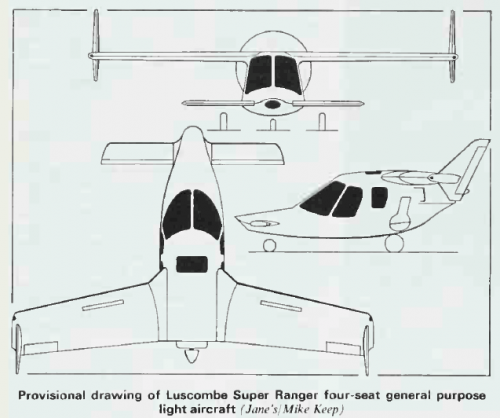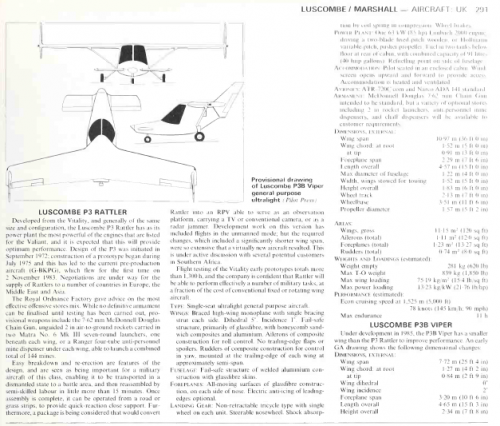[snip]
A descendant of Luscombe's earlier Valiant
two-seater, Rattler has been developed for close-support
missions, with the Royal Ordnance Factories advising on possible weapons.
The proposed armament of one 7-62mm Hughes Chain Gun
puts Rattler firmly into the "serious" category.
Other warload options include up to
14 2in unguided air-to-ground rockets,
or a landmine dispenser for rapid area denial,
carrying up to 144 anti-personnel mines.
Rattler philosophy is that of a simple, cheap aircraft
which can be disassembled, crated to a forward area,
rapidly assembled in the field, and operated from grass strips
or roads on quick-reaction close-support missions. Alternatively,
the airframe can be equipped as a drone for reconnaissance
of heavily defended targets.
The boot-shaped fuselage has a welded 3in aluminium
tube mainframe, while the wing comprises a box-section
main spar and I-section rear spar with polyurethane foam
interior filling. The fuselage and wing skins are of nonstressed
glassfibre, with the metal hardpoints for weapons
glassed into the primary structure. Fuel tanks are in
the wing centre-section and aircraft belly.
The cockpit is large and roomy, with a good view
ahead, down, and to the sides, marred only slightly by the
canard. A "chiselled" nose with an optically flat window
allows the fitting of electrooptical sensors, cameras, or a
laser target marker. Because the proposed mount for the
7 • 62mm gun is dictated by the c.g., the gun will be mounted
high on the starboard side of the fuselage with the
2,000-round magazine behind the pilot's seat, obviating trim
changes as the magazine empties.
Wing mounts could carry 2in, 101b unguided rockets in a
seven-round launcher on each side. An alternative load is a
four-tube Ranger antipersonnel mine dispenser on
each side. Each tube ejects 18 mines, giving a total field of
144. An electrically initiated cartridge fires the mines a
distance of 100m from a static launch. Each 18-round tube is
emptied in one second, and each mine takes 20sec to arm.
Time of flight from static launch is 15sec, giving five
seconds leeway for the revised ballistics of airborne launch.
A low-level dispensing run is therefore essential.
Rattler can easily be disassembled
for transport to a battle area. The two fins
mounted on the trailing edge inboard of the struts are
removed, the canards unplugged, and the wing derigged
into two parts. Rerigging in the field takes
two men about 15min. Pushpull control rods considerably
ease this task.
Take-off distance is predicted as 200ft from a grass
strip and 150ft from tarmac, over a 50ft obstacle with a
lift-off speed of 42kt. Climb rate is 800ft/min, and
Rattler's cruise and maximum speeds are 85kt and 100kt
respectively. At 2,700 r.p.m., fuel flow is 1 • 7gal/hr, giving a
speed of 80kt. Endurance is about 12hr for the drone version.
Stressed to +6/-3g, this type does not stall, says
Luscombe, but "squishes downwards at 27kt". Rattler
has a 600 n.m. range with a 6501b payload. Empty weight
is 4501b, giving a maximum take-off weight of around
1,1001b. For short-field landings the rudders are turned
inwards simultaneously to act as spoiler/airbrakes.
Rattler is powered by the Weslake 65/80-118-02, a two cylinder
880cc engine producing 80 b.h.p. at 3,400 r.p.m.
and weighing 1351b. Other engine options include a
Normalair Garrett 5 or the Risborough three-cylinder radial.
[snip]








